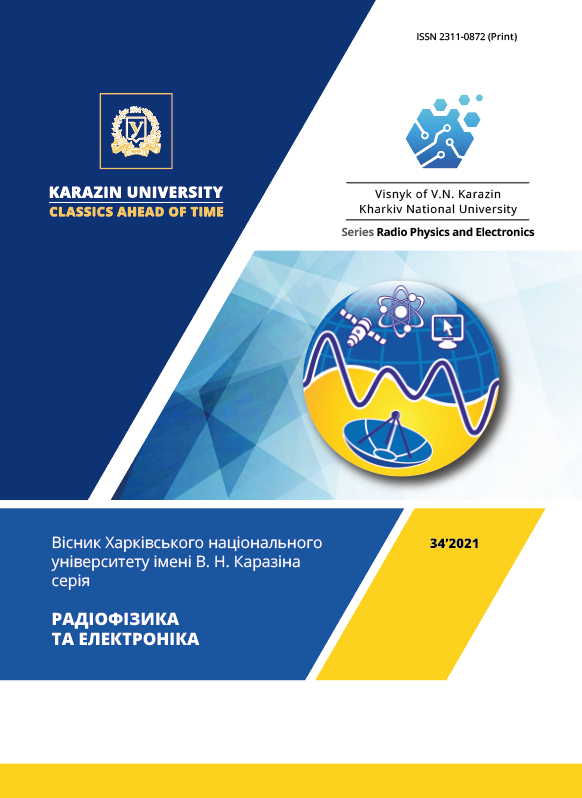Frequency selective surface with complex topology elements
Abstract
Relevance: The solution of specific problems in modern technology of microwave and UHF ranges, such as the implementation of reducing the radar signature of objects, spatial frequency-selective filters, reflectors requires the development and creation of a special class of electrodynamic structures - frequency-selective surfaces. Due to the uniqueness of their electrodynamic characteristics, it is possible to solve quite technically complex problems - suppression of excited surface waves, the creation of "forbidden" zones in the amplitude-frequency characteristics.
The purpose of the work is numerical modeling and experimental study of electrodynamic characteristics of plane frequency-selective surfaces with slotted elements of complex topology. Evaluation of the influence of the geometric parameters of the slot inhomogeneity and the material constants of the dielectric substrate on the reflection and transmission coefficients of the frequency-selective surface.
Materials and methods: The paper presents the results of numerical simulation of the electrodynamic characteristics of a cell of an infinite 2D frequency-selective surface with the topology of a structural element -shaped and experimental studies of the prototype parameters. Modeling was performed within the framework of the finite element method (FEM) using the ANSOFT HFSS / ANSYS software product. Characteristic measurements are performed in free space by direct measurement of attenuation values.
Results: In the course of numerical experiments, it was found that two types of resonances can arise in the structure, associated both with the ratio of the geometric dimensions of the structural element and with the presence of double-sided shielding. The influence of the thickness of the dielectric substrate and the values of the dielectric constant on the reflection and transmission coefficients is investigated. The frequency dependences of the reflection value are established with a change in the spatial orientation of the structure relative to the incident wave front. The dependence of the magnitude of the radio transparency of a two-layer frequency-selective surface on the angle of rotation of the structure around a given axis has been established experimentally.
Conclusion: The presented results of numerical simulation of the electrodynamic characteristics of a cell of an infinite 2D frequency-selective surface with the topology of a structural element -shaped and experimental studies have shown the possibility of spatial frequency selection. The totality of the results obtained makes it possible to predict the creation of sufficiently technological and highly efficient frequency-selective surfaces in the microwave range.
Downloads
References
2. Ghosh S. Broadband polarization-insensitive tunable frequency selective surface for wideband shielding. IEEE Transactions on Electromagnetic Compatibility. 2018; 60(1): 166–172. http://dx.doi.org/10.1109/TEMC.2017.2706359
3. Munk B.Frequency selective surfaces. Theory and design. NY, USA: John Wiley & Sons Inc .; 2000; 410.
4. Narayan S, Sangeetha B, Jha R. Frequency selective surfaces based high performance microstrip antenna. London: Springer Singapore Heidelberg New York Dordrecht; 2016; 45. https://doi.org/10.1007/978-981-287-775-8_1
5. Li H, Cao Q, Wang Y. A Novel 2-B Multifunctional Active Frequency Selective Surface for LTE-2.1 GHz. IEEE Transactions on Antennas and Propagation. 2017; 65(6): 3084– 3092. https://doi.org/10.1109/TAP.2017.2688927
6. Heppenheimer T. A. Stealth: First glimpses of the invisible aircraft now under construction. Popular Science. 1986. Vol. 229 (3): 74-79, 115-116.
7. Ma Y, Wu W, Yuan Y, Zhang X, Yuan N. A wideband FSS based on vias for communication systems. IEEE Antennas and Wireless Propagation Letters. 2018: 17(12): 2517–2520. https://doi.org/10.1109/LAWP.2018.2880219
8. Adlina M, Maisarah A. Performances of Flexibel Antenna with Ultra-Thin AMC and AMC with Multi-Layer FSS. International Conference on Engineering, Applied Sciences, and Technology (ICEAST). 2018: 1–4. https://doi.org/DOI:10.1109/ICEAST.2018.8434453
9. Rahmati B, Hassani H. Multi-Band Metallic Frequency Selective Surface with Wide Range of Band Ratio. IEEE Transactions on Antennas and Propagation. 2015: 63(8); 3747–3753. https://doi.org/DOI:10.1109/TAP.2015.2438340
10. Wei Xing-Chang, Shu Yu-Fei, Zhang Jian-Bo, Wang Dong. Applications of high impedance surfaces for surface wave elimination. URSI Asia-Pacific Radio Science Conference (URSI AP-RASC), 2016: 16408579. https://doi.org/10.1109/URSIAP-RASC.2016.7601333
11. Azad Mohammed Z., Ali Mohammod. Novel Wideband Directional Dipole Antenna on a Mushroom Like EBG Structure. IEEE Transaction on Antennas and Propagation, 2008; 56(5): 1242-1250. https://doi.org/10.1109/TAP.2008.922673
12. Ansoft HFSS /ANSYS Academic Research HF (5 tasks): 1 task(s) Permanent with TECS expiring 01-May-2020 Customer # 1076710.
13. Brillouin L. Wave Propagation in Periodic Structures, Electric Filters and Crystal Lattices. New York and London, 1946, p. 247
14. Mayboroda D.V., Pogarsky S.A. Simulation of Paramaters of Frequency Selective Surface in Microwave Band. XI International Scientific Conference “Functional Basis of Nanoelectronics”, Odesa, Ukraine, 2020: 99-101.




